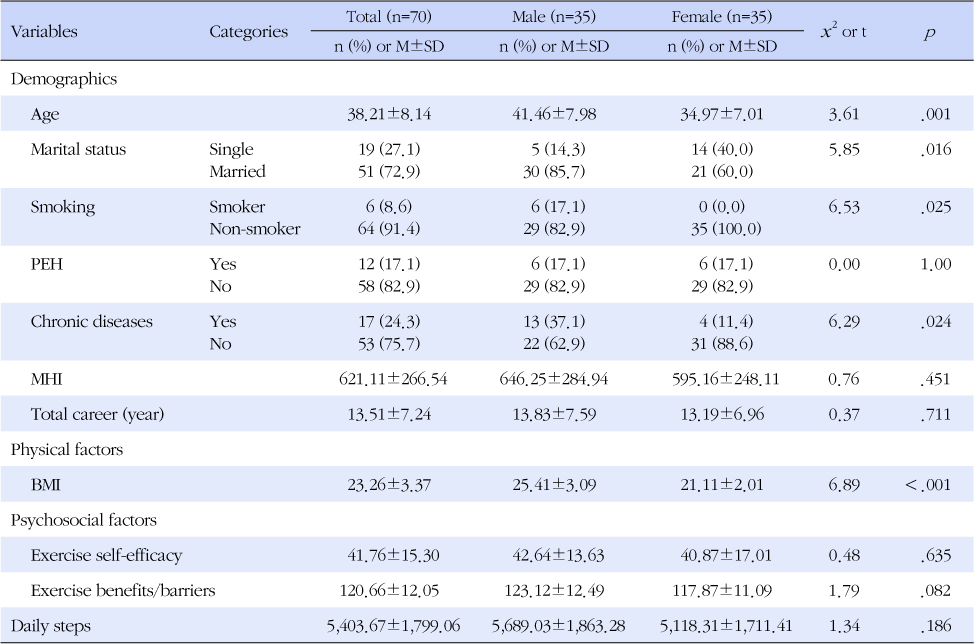References
1. Bandura A. Self-efficacy: The exercise of control New York: Freeman & Co; 1997.
2. Bittman M, Wajcman J. The rush hour: The character of leisure time and gender equity. Soc Forces 2000;79(1):165–189.
3. Brown WJ, Trost SG. Life transitions and changing physical activity patterns in young women. Am J Prev Med 2003;25(2):140–143.
5. Del Duca GF, Nahas MV, Garcia LM, Mota J, Hallal PC, Peres MA. Prevalence and sociodemographic correlates of all domains of physical activity in Brazilian adults. Prev Med 2013;56(2):99–102.
6. Hao L, Naiman DQ. Quantile regression Thousand Oaks, CA: Sage Publications; 2007.
7. Jang HJ, Shin YH. The cultural verification and psychometric evaluation of the exercise benefits/barriers scale for Korean adults with chronic disease In : Paper presented at the meeting of the 1st Asian-Pacific Nursing Congress Conference. Seoul, Korea; 1999. 12.
8. Kaewthummanukul T, Brown KC. Determinants of employee participation in physical activity: Critical review of the literature. AAOHN J 2006;54(6):249–261.
9. Kim EK, Kim BG, Park JT, Kim HR, Koo JW. Factors affecting the health promotion activities of workers. Korean J Occup Environ Med 2007;19(1):56–64.
10. Kim HK, Kim MJ, Park CG, Kim HO. Do the determinants of physical activity change by physical activity level? J Adv Nurs 2009;65(4):836–843.
11. Kim YS. Wage determinants in the Korean labour market. Korean J Ind Relat 2009;19(2):1–25.
12. Koenker R, Bassett G. Regression quantiles. Econometrica 1978;46(1):33–50.
14. Lee S, Cho E, Grodstein F, Kawachi I, Hu FB, Colditz GA. Effects of marital transitions on changes in dietary and other health behaviours in US women. Int J Epidemiol 2005;34(1):69–78.
15. Lim SJ. The effects of prevalence and metabolic syndrome index on life style of adults Chuncheon: Kangwon National University; 2011. Unpublished master' thesis.
16. McAuley E, Courneya KS, Rudolph DL, Lox CL. Enhancing exercise adherence in middle-aged males and females. Prev Med 1994;23(4):498–506.
17. Ministry of Health & Welfare. Korea health statistics 2010: Korea National Health & Nutrition Examination Survey (KNHANES v-1) Seoul: Author; 2011.
18. Muto T, Saito T, Sakurai H. Factors associated with male workers' participation in regular physical activity. Ind Health 1996;34(4):307–322.
19. Nomaguchi KM, Bianchi SM. Exercise time: Gender differences in the effects of marriage, parenthood, and employment. J Marriage Fam 2004;66(2):413–430.
20. Pitsavos C, Panagiotakos DB, Lentzas Y, Stefanadis C. Epidemiology of leisure-time physical activity in socio-demographic, lifestyle and psychological characteristics of men and women in Greece: The ATTICA Study. BMC Public Health 2005;5:37.
21. Sallis JF, Hovell MF, Hofstetter CR. Predictors of adoption and maintenance of vigorous physical activity in men and women. Prev Med 1992;21(2):237–251.
22. Sechrist KR, Walker SN, Pender NJ. Development and psychometric evaluation of the exercise benefits/barriers scale. Res Nurs Health 1987;10(6):357–365.
23. Seo KM. Analysis of physical activity in male office workers. J Korean Community Nurs 2003;14(1):95–105.
24. Shin Y, Jang HJ, Pender NJ. Psychometric evaluation of the exercise self-efficacy scale among Korean adults with chronic diseases. Res Nurs Health 2001;24(1):68–76.
25. Schmidt CM, Tauchmann H. Heterogeneity in the intergenerational transmission of alcohol consumption: a quantile regression approach. J Health Econ 2011;30(1):33–42.
26. Steele R, Mummery K. Occupational physical activity across occupational categories. J Sci Med Sport 2003;6(4):398–407.
27. Stutts WC. Physical activity determinants in adults. Perceived benefits, barriers, and self efficacy. AAOHN J 2002;50(11):499–507.
28. Tudor-Locke C, Bassett DR. How many steps/day are enough? Preliminary pedometer indices for public health. Sports Med 2004;34(1):1–8.
29. Tudor-Locke C, Sisson SB, Lee SM, Craig CL, Plotnikoff RC, Bauman A. Evaluation of quality of commercial pedometers. Can J Public Health 2006;97(Supp 1):S10–S15.
:S10–S16.


